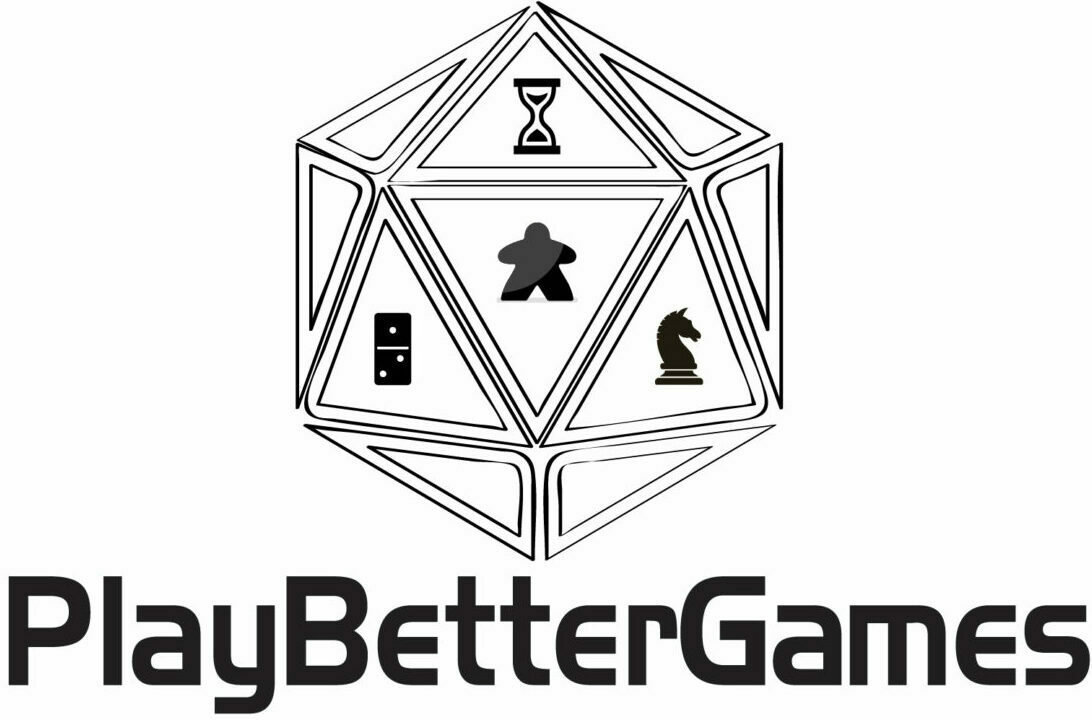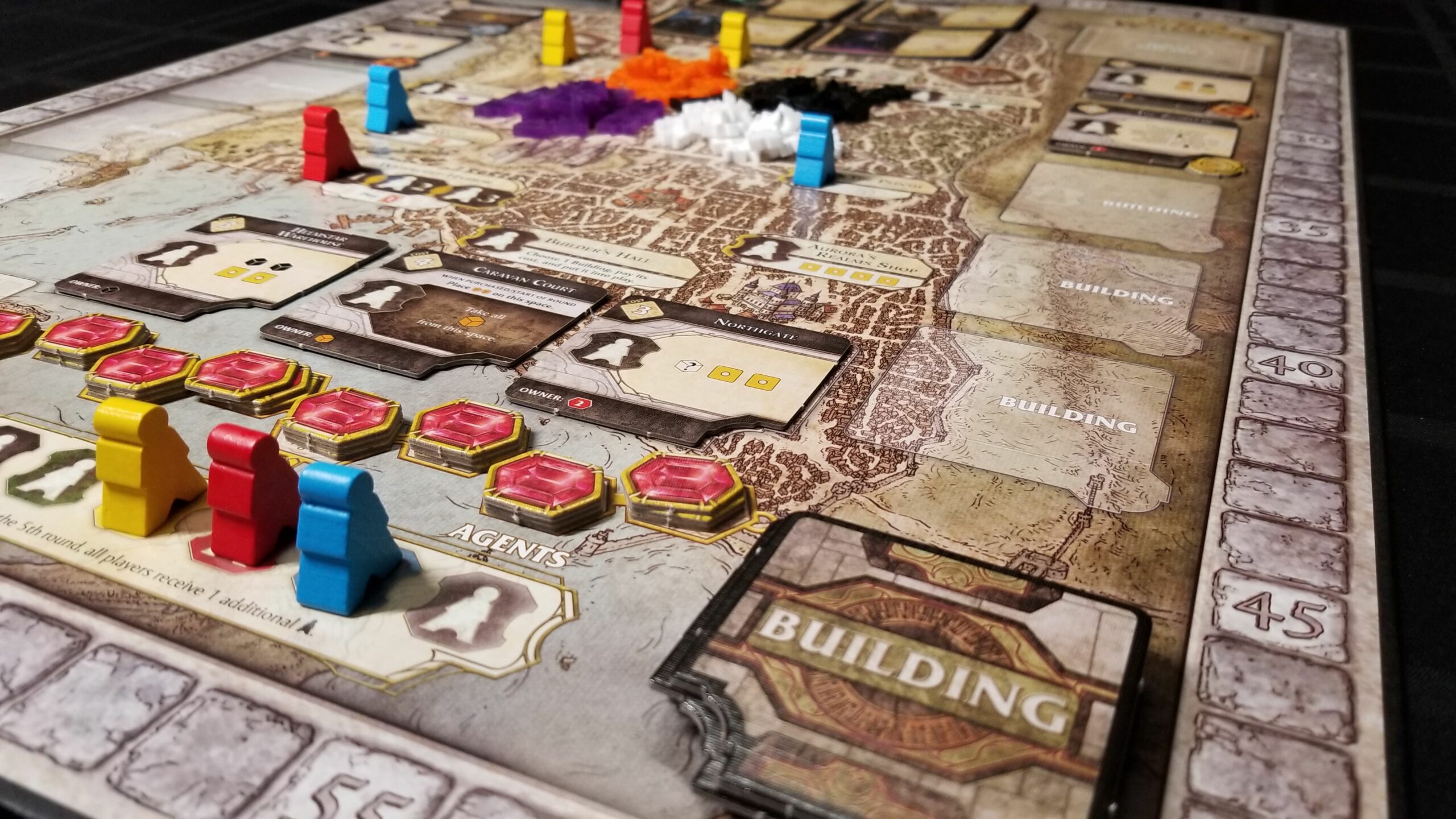A worker placement game is a type of board game in which players take turns placing their game pieces (often called “workers”) on various spaces on the board to take actions or gather resources. The game often involves players competing to complete certain objectives. Worker placement games often require players to strategize and plan ahead in order to make the most efficient use of their workers and resources.
Example of a Worker Placement Game (Lords of Waterdeep)
Lords of Waterdeep was released in 2012 and was the first worker placement game I played. It takes place in the famous town of Waterdeep from Dungeon & Dragons. We’ll use this game to explain worker placement games in general because it is a good example of a pure worker placement game. Later in the post I’ll recommend some other games that add novel mechanics to the worker placement concept
In Lords of Waterdeep you play as one of the secret rulers of the city and use your agents to recruit heroes that will complete quests on your behalf. The game plays between 2 and 5 players and is a great entry point into the worker placement genre for fans of D&D. We didn’t get into D&D until recently, but we’ve had this game on our shelf for a long time. You don’t need to be familiar with Waterdeep or any Dungeon’s and Dragons lore in order to play.
Example Quests
You’ll earn points in Lords of Waterdeep by completing quests. Each quest requires a specific mix of adventures and sometimes other resources to complete. You’ll need to recruit the right team of cleric, fighters, rouges and wizards to send on each quest. Each type of adventurer is represented by a color, the game comes with little wooden colored blocks, but you can purchase an upgraded set of meeples which makes it easier to tell which are which.
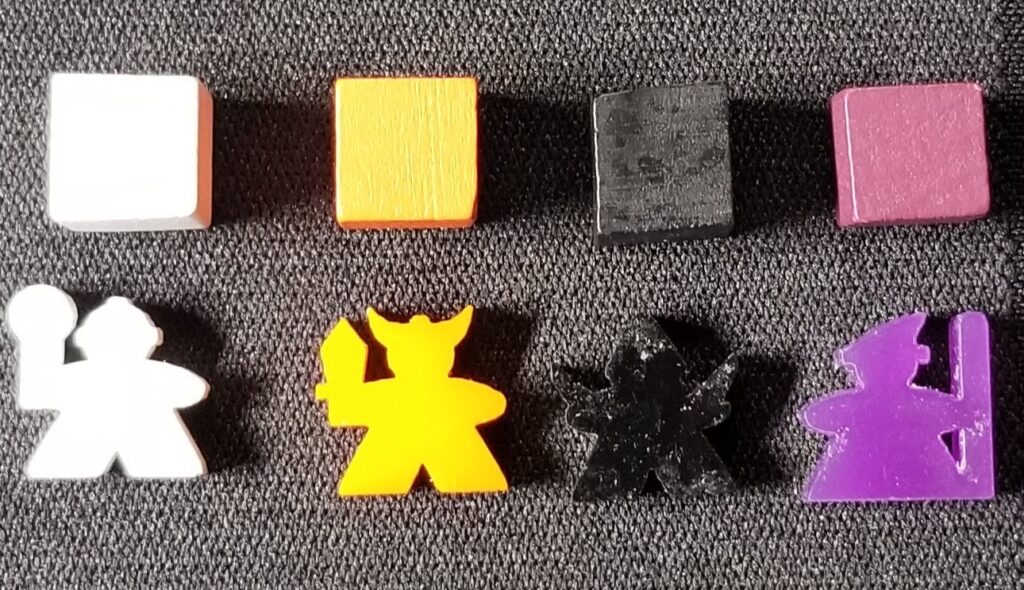
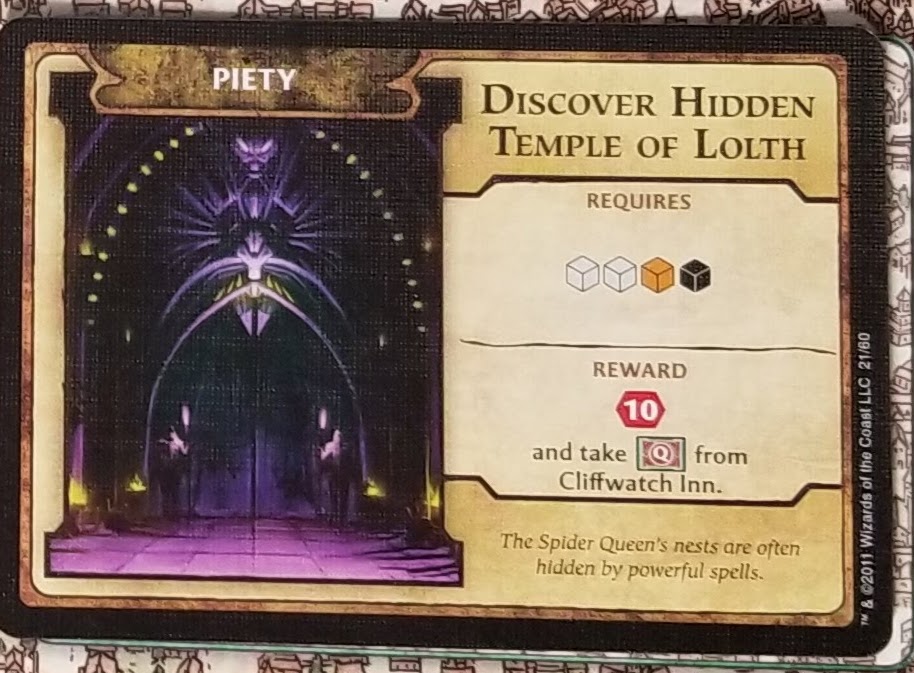
Here is an example of a quest in the game. Each player starts the game with two quests to complete. These quest are public knowledge so everyone knows what other players goals are. In order to complete the “Discover Hidden Temple of Lolth” quest, you’ll need to send two clerics, a fighter and a rogue.
If you are able to complete this quest you receive 10 victory points and you’ll get another quest for free. Under normal circumstances you have to send agents to Cliffwatch Inn to get more quests.
How to Recruit Adventurers
In a worker placement game you take actions by placing one of your workers in the space for that action.
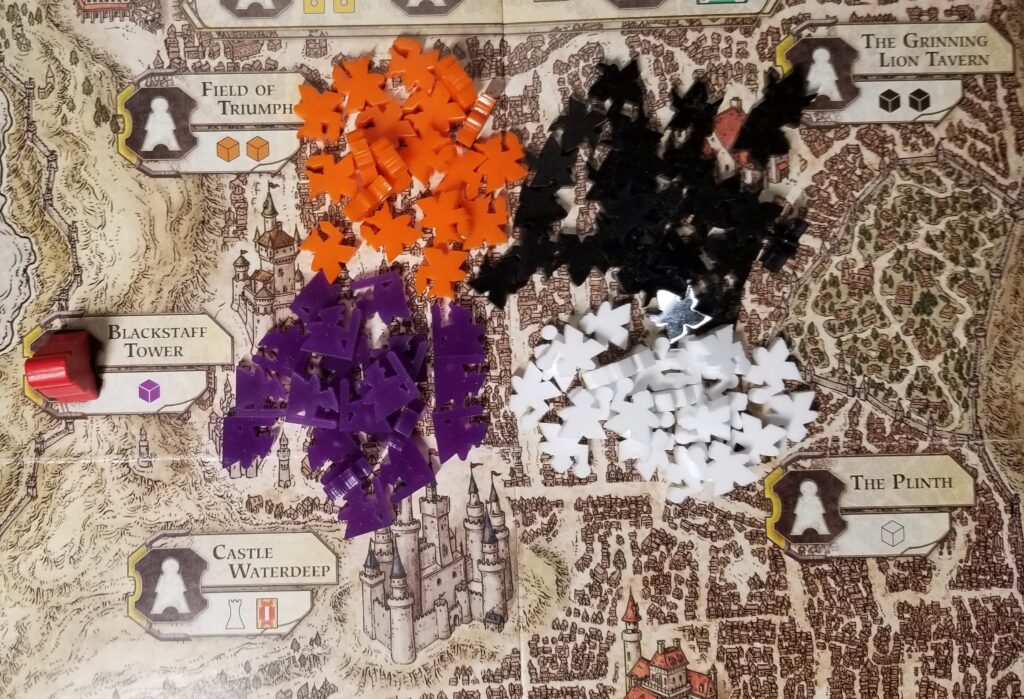
Here is a section of the board where you can recruit adventurers. Placing an agent at the Field of Triumph will net you two fighters, while going to Blackstaff Tower will result in a wizard joining your cause. Once a player goes to a space, no one else is allowed to take that action until the next round when the workers are cleared from the board.
Taking Other Actions
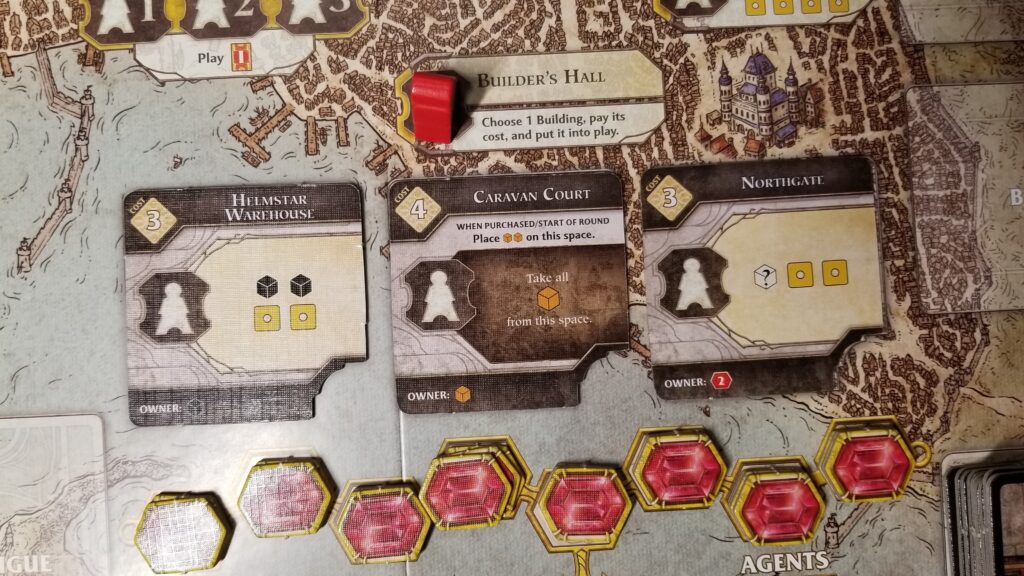
In order to do anything. in a worker placement game you’ll need to spend a worker to do it. If you want to get a new card, or play a card you’ll have to place an agent in the space that allows you to take that action. One of the actions you can take is to build a new building by going to builders hall. These buildings are placed on the board and become additional action spaces that players can visit during their turn.
The owner of the building also places a marker next to building denoting themselves as the owner. Whenever a player goes to one of your buildings and takes it action you receive an additional benefit.
There are lots of different actions you can take in Lords of Waterdeep as well as Intrigue Cards you can play to enhance the game and expand your strategy. We’ll be writing a full review of this game in the near future, but I hope this gives you a good introduction into the game mechanics in a Worker Placement game!
Benefits of Worker Placement Games
There are a lot of reasons people enjoy worker placement games.
- Strategy: Worker placement games often require players to carefully plan and strategize their moves in order to be successful.
- Resource management: Players must often manage and allocate their limited resources (such as workers or time) in order to complete tasks and advance their goals.
- Player Interaction: Worker placement games often involve interacting with other players, whether through direct competition or cooperation.
- Decision-making: Players must make tough decisions about which tasks to prioritize and how to allocate their resources in order to achieve their goals.
- Replayability: Worker placement games often have high replayability due to the different strategies that can be employed and the various paths to victory.
If these are things you would enjoy, worker placement games may be for you!
Strategies for Winning Worker Placement Games
There are many strategies that can be employed to win worker placement games, but here are a few general tips:
- Plan ahead: Look at the available action spaces and try to predict which ones will be the most valuable or useful to you in the future. This can help you prioritize which actions to take and when.
- Be efficient: Try to get the most out of each action you take by choosing actions that will give you the biggest return on investment.
- Specialize: Focusing on a few specific actions or resources can often be more effective than trying to do everything at once.
- Stay flexible: Be prepared to change course if your original plans are no longer viable. Sometimes it’s better to adapt to the game state rather than sticking to a predetermined plan.
- Block your opponents: If you can’t take an action that you really want, consider taking it just to prevent your opponent from using it.
- Don’t spread yourself too thin: Don’t try to do too many things at once, as this can lead to inefficiency and leaving valuable resources unused.
- Pay attention to the end game: Make sure you are positioning yourself well for the end game, as this can be the key to victory.
- Don’t be afraid to take risks: Sometimes taking a risk can pay off, especially if you are able to anticipate and prepare for potential negative outcomes.
Other Worker Placement Games You Should Try!
One of the great things about worker placement games is that the mechanic lends itself to a variety of different themes. It is common that you’ll be building things or producing goods, but you could be a playing as a wine maker, a medieval lord, or a furry woodland creature. No matter what you like, you can probably find a worker placement game with a theme you will enjoy. Here is a list of some good ones to get you started, and illustrate what I mean.
Kingsburg
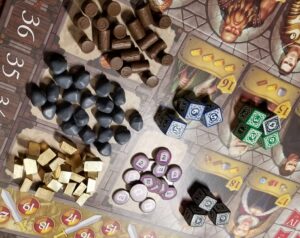
In Kingsburg you play as a Medieval lords sent by the king to build and defend your territory. The unique thing about Kingsburg is that the spaces you are allowed to occupy each turn are determined by dice rolls. Instead of having workers each player roll three dice and each of the resource locations is assigned a number. You visit a location by placing dice that add to that value in the space. There are a number of ways you can manipulate your dice based on the buildings you choose to build in your territory. This is a fantastic worker placement game for both new and veteran gamers.
Architects of the West Kingdom
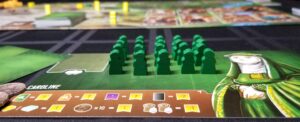
In most worker placement games you get 3-4 workers to play with, In Architects of the West Kingdom you get 20! Architects is an interesting worker placement game because when a worker is placed in this game you do not get them back at the end of the round, and their effect is cumulative. The more workers you have at a location the more of that resource you’ll get each round. If your opponent wants to stop this they can use one of their workers to round up all of the workers at a location and send them to jail. When you free your workers from jail they are available to you again. This is a mechanic I have not seen in any other worker placement games and it’s one I enjoy. I’ll do a full write-up on Architects of the West Kingdom in the near future.
Raiders of the North Sea
Raiders of the North Sea is a worker placement game set in the Viking Age. Players are Viking warriors leading expeditions to raid settlements and earn glory. Players collect resources, hire crew members, and embark on raids. As players complete raids and gain glory, they advance in rank. This game adds an interesting mechanic where you get to place a worker on the board and also TAKE a worker from the board and you get to take BOTH of the actions. It also adds different types of workers and spaces that require workers of specific types. These added mechanics make this an interesting. addition to your worker placement collection.
Viticulture
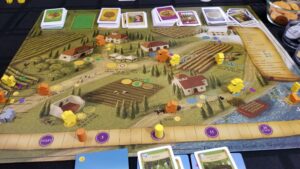
In Viticulture, players are winemakers in old-world Italy trying to build their winery, make the best wine they can, and fill wine orders. The game can play up to 6 players but it is typically best with 3-4 players. Viticulture has a playing time of about 90 minutes (we typically get through a two-player game in about 45 minutes). This is a fantastic game and it’s one we play frequently. I wouldn’t suggest it as your first worker placement game, but if you find you like the genre and are interested in the theme, pick this one up!
Final Thoughts
Worker placement is one of my favorite types of games. They are very strategic, allow you to make decisions that feel impactful and generally have a decent amount of player interaction. The worker placement mechanic also lends itself to a variety of themes and offer a lot of replayability. Hopefully this post has given you a good introduction to the genre and will encourage you to try one of the great games recommended here. Happy gaming!
